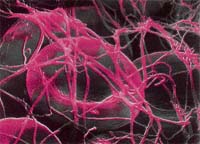Cutting clots
 clotbusting genes, activated by blood, could soon prove to be life-savers for the millions prone to thrombosis, strokes and heart attacks. Together, these diseases account for a formidable percentage of annual deaths in the world.
clotbusting genes, activated by blood, could soon prove to be life-savers for the millions prone to thrombosis, strokes and heart attacks. Together, these diseases account for a formidable percentage of annual deaths in the world.
Larry McIntire and his colleagues at Rice University in Texas, usa, have discovered a gene promoter that becomes active only in the blockage-prone regions of the human bloodstream. This promoter, which then activates numerous other genes in the vicinity, is "switched on" by endothelial cells. These are the cells which line the walls of our blood vessels. To keep these clot-prone areas clear, the researchers want to tether this promoter to a gene that can produce a chemical effective enough to dilute clots (New Scientist, Vol 158, No 2128).
The promoter only works in regions where the blood flow over the vessel walls leads to low drag forces. The gene usually triggers production of endo-thelin-1, a compound that adjusts the flow of blood by constricting the vessels.
Regions where shear stresses are low, the vessels are most likely to suffer clogging from fatty plaque deposits and blood clots. "Our observation is that lots of vascular diseases occur at selected or preferential sites within the vessels like junctions and the branching points," McIntire explains.
In the regions of the bloodstream that normally remain clear of blockages, shear stresses are higher and they trigger the endothelial cells of the vessel wall to release a clot-busting substance called the tissue plasminogen activator (tpa). The gene that makes tpa is tethered to a different promoter which is only triggered by high shear stresses. The tpa gene is usually dormant in areas most prone to clotting.
McIntire says that the drag forces are around 10 times as high in the highly stressed regions - typically around 0.00025 newtons per square centimetre of vessel wall - so there is plenty of scope for relying on mecha-nical forces to trigger genes. His initial proposal is to tether the low-shear stress promoter to the gene that makes tpa. This would enable the tpa to be produced in the areas most prone to be clogged. "We may be able to convert arteriosclerosis-prone regions to areas that are not vulnerable," he explains.
Already, McIntire has shown that the system works in an artificial network of blood vessels made from human endothelial cells grafted onto glass surfaces to simulate vessel walls. By mimicking areas of high and low shear stress that occur in real blood vessels, McIntire showed that the promoter and its tpa-producing gene would work in the low-stress regions. He also showed that the pair lay dormant in high-stress zones, where there is already enough natural tpa anyway. "We're now getting ready to do these types of experiments in animal models," says McIntire.
Russell Medford, a specialist in atherosclerosis and founder of Georgia-based company AtheroGenics, says that the most crucial thing to prove is that the promoter will be selective enough to work only in regions that are prone to plaque. If excess tpa is produced in the wrong areas, he says, it could lead to fatal internal bleeding.
